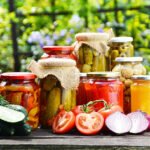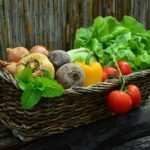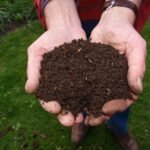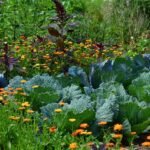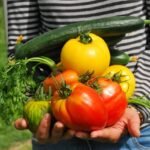survivalgardencompany.com
The One Skill That Could Save Your Family in a Crisis!
Essential Homesteading Skills for Backyard Self-Sufficiency
Grow resilience with gardening skills, natural pest control, and community barter networks.
Why Skills and Community Matter
Self-sufficiency isn’t just about what you grow—it’s about resilience. Skills and networks help you thrive through challenges.
How to Build Skills & Community
1. Learn Essential Skills
- Seed saving to preserve your best plants.
- Natural pest control (neem oil, companion planting).
- Composting and crop rotation.
2. Join Groups
- Find local homesteading or gardening groups.
- Attend workshops or community garden days.
3. Trade and Barter
- Swap eggs for veggies or help a neighbor in exchange for tools.
- Build a resilient network.
This article contains affiliate links. If you make a purchase, I may earn a small commission at no extra cost to you.
Shopping List
- Gardening books or online courses
- Seed-saving envelopes
- Neem oil spray
- Notebook for tracking skills/lessons
👉 Click here to get 7 Steps to a Self-Sufficient Backyard
👉 Click here to get your Local Survival Gardening Calculator
Turn 1 Week of Harvest Into 6 Months of Food!
How to Preserve Your Harvest: Canning, Freezing & Dehydrating
Learn easy methods to preserve your garden harvest and enjoy fresh food year-round.
Why Preservation Matters
Fresh produce is terrific, but it doesn’t last long. Preservation ensures food security year-round, reduces waste, and stretches the value of your garden. Learning to store your harvest is just as important as growing it.
How to Preserve
1. Canning
Canning uses heat to seal food in jars, preventing bacterial growth. It works best for high-acid foods like tomatoes, fruits, jams, and pickles. Pressure canning expands the options to low-acid foods like beans and meats.
-
Best for: Tomatoes, fruits, jams, salsas, pickles, beans, soups.
2. Dehydrating
Dehydrating removes moisture from food, making it shelf-stable for months. You can dry foods with a dehydrator, oven, or even the sun.
-
Best for: Herbs, apples, bananas, tomatoes, jerky, and snack chips like zucchini or kale.
3. Freezing
Freezing locks in freshness quickly, preserving texture and nutrients. Most vegetables should be blanched (boiled briefly, then cooled) before freezing to stop enzyme activity.
-
Best for: Corn, beans, broccoli, spinach, berries, peppers, and pre-cooked meals.
4. Fermenting
Fermentation uses natural bacteria and salt brine to transform vegetables into probiotic-rich foods. It adds flavor and long-lasting nutrition.
-
Best for: Cabbage (sauerkraut, kimchi), cucumbers (pickles), carrots, beets, and peppers.
This article contains affiliate links. If you make a purchase, I may earn a small commission at no extra cost to you.
Shopping List
-
Water-bath canner or pressure canner
- Pressure canning guide
-
Dehydrator or oven with low setting
-
Freezer bags/containers
-
Fermentation jars or crocks, airlock lids, and sea salt
👉 Click here to get 7 Steps to a Self-Sufficient Backyard
👉 Click here to get your Local Survival Gardening Calculator
Backyard Chickens: The Secret to Never Buying Eggs Again!
How to Raise Chickens and Rabbits for Backyard Self-Sufficiency
From chickens to rabbits to sprouts, discover small-scale protein options for backyard survival.
Why Protein Sources Matter
Vegetables are essential, but protein completes your self-sufficiency. You don’t need a farm—small spaces can still provide eggs and meat.
How to Add Protein
1. Raise Chickens
- Choose hardy breeds for eggs (Rhode Island Red, Leghorn).
- Provide a coop with 4 sq. ft. per bird.
- Feed balanced pellets plus scraps.
- Collect eggs daily.
2. Try Rabbits
- Keep in hutches, needing only 3–4 sq. ft. per rabbit.
- Feed hay, pellets, and greens.
- Rabbits breed quickly—great meat source.
3. Plant-Based Proteins
- Sprout seeds (alfalfa, mung beans) for quick protein-rich greens.
- Beans and peas add variety.
This article contains affiliate links. If you make a purchase, I may earn a small commission at no extra cost to you.
Shopping List
- Chicken coop kit + feed
- Rabbit hutch + feed
- Sprouting jar kit
- Starter packs of beans and peas
👉 Click here to get 7 Steps to a Self-Sufficient Backyard
👉 Click here to get your Local Survival Gardening Calculator
Save Thousands with This Simple Backyard Water Hack!
How to Collect and Store Rainwater for Backyard Survival Gardens
Learn to collect rainwater, set up drip irrigation, and conserve water for your backyard garden
Why Water Storage Matters
In droughts or emergencies, reliable water can save your garden. Storing and conserving water ensures your crops survive dry spells.
How to Store and Use Water
1. Collect Rainwater
- Install rain barrels under downspouts.
- Use food-grade barrels with spigots.
- Cover barrels with mesh to prevent mosquitoes.
2. Drip Irrigation
- Use hoses with emitters that deliver water directly to plant roots.
- Save water compared to sprinklers.
3. Mulching for Water Retention
- Apply mulch around plants to reduce evaporation.
4. Reuse Greywater
- Collect water from sinks or showers (without harsh chemicals).
- Redirect to ornamental plants or trees.
This article contains affiliate links. If you make a purchase, I may earn a small commission at no extra cost to you.
Shopping List
- Rain barrel kit
- Downspout diverter
- Drip irrigation kit
- Mulch material (straw, wood chips)
👉 Click here to get 7 Steps to a Self-Sufficient Backyard
👉 Click here to get your Local Survival Gardening Calculator
7 Crops That Practically Grow Themselves (and Feed You Nonstop!)
Best High-Yield Crops to Grow in Your Backyard Garden
Maximize your backyard harvest with fast-growing, high-yield crops that provide food security year-round.
Why Focus on High-Yield Crops?
Not all plants produce equally. Some take months for little reward, while others feed you in weeks. High-yield crops maximize food from limited space.
How to Grow High-Yield Crops
1. Start with Easy, Fast Growers
- Radishes: Ready in 25 days.
- Lettuce: Cut-and-come-again for continuous harvests.
- Green beans: Fast, reliable, and heavy producers.
2. Add Reliable Staples
- Potatoes: Grow in bags or raised beds, yield pounds per plant.
- Zucchini: One plant produces abundantly.
- Tomatoes: Versatile and great for preserving.
3. Plant Perennials for Long-Term
- Berry bushes (blueberries, raspberries).
- Asparagus and rhubarb for yearly returns.
4. Succession Planting
- Stagger planting dates so crops mature continuously.
- Replace harvested crops immediately with new seedlings.
This article contains affiliate links. If you make a purchase, I may earn a small commission at no extra cost to you.
Shopping List
- Packets of fast-growing seeds (radish, lettuce, beans)
- Potato grow bags or raised beds
- Tomato cages or stakes
- Berry bush starters
👉 Click here to get 7 Steps to a Self-Sufficient Backyard
👉 Click here to get your Local Survival Gardening Calculator
This Dirt Trick Could Feed Your Family Forever!
How to Build Healthy Soil for Backyard Gardening
Discover composting, worm bins, and mulching tips to create fertile soil for a thriving backyard garden.
Why Healthy Soil Matters
Healthy soil is alive, teeming with organisms that feed your plants. Without it, crops fail, pests thrive, and yields shrink. Building rich soil ensures long-term success.
How to Build Healthy Soil
1. Start Composting
- Choose a bin (compost tumbler, wooden crate, or wire enclosure).
- Balance “greens” (food scraps, coffee grounds) with “browns” (leaves, cardboard).
- Layer them in 2:1 ratio (browns:greens).
- Turn weekly and keep moist like a sponge.
- In 2–4 months, harvest rich compost.
2. Try Worm Composting (Vermicomposting)
- Get a worm bin or make one with a plastic tub.
- Add bedding (shredded paper, cardboard).
- Introduce red wigglers (Eisenia fetida).
- Feed scraps (veggie peels, coffee grounds). Avoid meat, dairy, and citrus.
- Harvest worm castings every 2–3 months.
3. Mulch to Protect Soil
- Spread straw, wood chips, or shredded leaves around plants.
- Keeps soil moist, prevents weeds, and adds organic matter.
4. Avoid Chemicals
- Skip synthetic fertilizers that harm soil microbes.
- Use compost, worm castings, and natural amendments.
This article contains affiliate links. If you make a purchase, I may earn a small commission at no extra cost to you.
Shopping List
- Compost bin or tumbler
- Red wiggler worm kit
- Bedding (newspaper/cardboard)
- Mulch (straw, chips)
- Soil test kit
👉 Click here to get 7 Steps to a Self-Sufficient Backyard
👉 Click here to get your Local Survival Gardening Calculator
You Won’t Believe How Much Food Fits in a Tiny Backyard!
How to Plan Your Backyard for a Self-Sufficient Garden
Learn how to design your backyard layout for maximum food production, even in small spaces.
Why Planning Matters
Before planting a single seed, take time to understand the conditions of your yard. Start by watching how the sun moves across your space throughout the day. Most vegetables thrive on 6–8 hours of direct sunlight, so take note of the sunniest spots. Shadier areas aren’t wasted though — they’re perfect for leafy greens, herbs, or cool-season crops.
How to Plan Your Backyard
1. Assess Your Space
-
Next, pay attention to how water behaves in your yard. After a rain, observe where water tends to pool and where it drains quickly. Low-lying areas can drown plants, while dry patches may need extra irrigation. Knowing this helps you plan where to place raised beds, pathways, or rain barrels for maximum efficiency.
-
Finally, measure your space. Even small yards, patios, or balconies can be transformed into productive gardens when you know exactly how much room you have. Sketch out the dimensions so you can visualize beds, containers, or vertical structures.
-
By assessing your sunlight, water, and space upfront, you set yourself up for fewer mistakes, healthier plants, and a much more abundant harvest.
2. Sketch a Layout
- Draw a simple map of your yard. Plan where your raised beds, compost bins, and walkways will go.
- Leave room for expansions like chickens, fruit trees, a greenhouse, containers, or additional beds.
- Note the path of the sun, and where your water naturally pools.
3 Think Vertical
- Don’t limit yourself to just the ground — use the space above it! Vertical gardening allows you to grow more food in less square footage while keeping your plants healthier and easier to manage.
- Use trellises or wire supports for vining crops like beans, cucumbers, and peas. Add cages or sturdy stakes for tomatoes to keep fruit off the soil and prevent rot. For herbs or strawberries, consider hanging planters, wall-mounted pockets, or stacked shelves that bring food production upward.
- Not only does vertical gardening save valuable space, it also improves airflow, reduces pest problems, and makes harvesting easier. By training plants upward, you can maximize every inch of your backyard — even on patios, balconies, or small city lots.
4. Start Small
-
One of the biggest mistakes new gardeners make is trying to do too much at once. Instead of building a huge garden right away, begin with just one or two raised beds or a handful of large containers. This lets you learn the basics of soil, watering, and pests without feeling overwhelmed.
-
Choose easy, reliable crops like lettuce, beans, or tomatoes. Lettuce grows quickly and keeps producing, beans are low-maintenance and rewarding, and tomatoes thrive with just a bit of support. By focusing on a few crops, you’ll gain confidence, enjoy early success, and reduce frustration.
-
Once you’ve mastered those, you can expand your garden gradually — adding more beds, trying new crops, and experimenting with techniques like succession planting or vertical growing. Starting small keeps gardening fun, manageable, and sustainable, ensuring you’ll stick with it for years to come.
4. Think Vertical
- Don’t limit yourself to just the ground — use the space above it! Vertical gardening allows you to grow more food in less square footage while keeping your plants healthier and easier to manage.
- Use trellises or wire supports for vining crops like beans, cucumbers, and peas. Add cages or sturdy stakes for tomatoes to keep fruit off the soil and prevent rot. For herbs or strawberries, consider hanging planters, wall-mounted pockets, or stacked shelves that bring food production upward.
- Not only does vertical gardening save valuable space, it also improves airflow, reduces pest problems, and makes harvesting easier. By training plants upward, you can maximize every inch of your backyard — even on patios, balconies, or small city lots.
Smart planning today saves you time, energy, and frustration down the road. 🌱 If you want a complete step-by-step blueprint for transforming your backyard into a true food powerhouse, check out The Self-Sufficient Backyard.
👉 And don’t miss our free planting guide, customized by your ZIP code, so you’ll always know the best time to grow in your area.
This article contains affiliate links. If you make a purchase, I may earn a small commission at no extra cost to you.
Shopping List
- Graph paper or garden planner app
- Raised bed kit or lumber
- Basic hand tools (spade, hoe, rake)
- Trellis or vertical garden supports
👉 Click here to get 7 Steps to a Self-Sufficient Backyard
👉 Click here to get your Local Survival Gardening Calculator
Cultivating Your Greens: A Beginner’s Guide to Starting a Vegetable Garden
Starting a vegetable garden can be an enriching experience, bringing fresh produce to your table and a sense of achievement to your day. If you’re looking to dive into the world of homegrown food, here’s a comprehensive guide to help you grow a bountiful garden, even if you’ve never so much as planted a seed before.
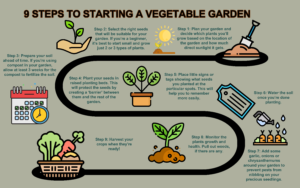
Step 1: Garden Planning 101
The journey of a thousand salads begins with a single plan. Choosing the right location for your garden is critical. Look for a spot that receives ample sunlight since most vegetables need about 6 to 8 hours of direct light each day. Consider the proximity to a water source and the quality of the soil in your chosen area.
Step 2: Seed Selection
Your seeds are the foundation of your garden. Research which plants thrive in your region and align with your culinary preferences. Starting with 2 or 3 plant types is advisable to avoid overwhelming yourself. Think about starting with hardy vegetables like lettuce, radishes, or cherry tomatoes, which are forgiving and suitable for beginners.
Step 3: Soil Preparation
Soil is more than just dirt; it’s a living ecosystem. Preparing your soil with compost enriches it with nutrients essential for plant growth. Aim to mix in the compost about 3 weeks before you plan to plant, giving the soil ecosystem time to adjust.
Step 4: Raised Beds
Consider raised planting beds to offer better drainage, reduce weed problems, and ease the strain on your back when planting and harvesting. They also help protect your seedlings from some pests and create a tidy, organized garden space.
Step 5: Labeling
As your seeds go into the ground, label them. This not only helps you remember what you planted where but also allows you to track their progress and learn from the growing process. You can use popsicle sticks, stones, or store-bought garden markers—anything that withstands the elements.
Step 6: Watering Wisdom
Water is a vital ingredient for your garden, but balance is key. Water your garden thoroughly after planting and maintain consistent moisture levels as your plants grow. Avoid over-watering, which can drown roots and diminish oxygen in the soil.
Step 7: Natural Pest Control
Protect your young garden by planting natural repellents. Garlic, onions, and chrysanthemums can deter pests while adding more variety to your harvest. They act as natural pest control, reducing the need for chemical pesticides.
Step 8: Garden Vigilance
Monitoring your garden for plant health and growth is essential. Regularly check for and remove weeds, which compete with your veggies for nutrients and sunlight. Also, be on the lookout for signs of pests or diseases, and take action early to prevent spreading.
Step 9: Harvest Time
The most rewarding step is harvesting. Vegetables taste best when they are picked at the peak of their ripeness. Some plants, like lettuce and herbs, can be harvested continuously. Learn the signs of ripeness like color, size, and firmness for each type of vegetable you grow.
Conclusion
Gardening is a cyclical process, each step leading naturally to the next. From planning to planting, watering to weeding, each action you take in the garden is a step towards a healthier lifestyle. It’s not just about the produce you harvest but also about the lessons learned and the satisfaction gained from growing your own food.
Embrace the journey, and before you know it, you’ll be enjoying the fruits (and vegetables) of your labor. Remember, every gardener has to start somewhere, and with these nine steps, you’re well on your way to cultivating a green thumb and a greener life.
The Green Pharmacy: Cultivating Wellness in Your Backyard
In the heart of every green space, there lies the potential for not just beauty but also well-being. The modern food garden has transcended its utilitarian roots to become a source of health and healing. As people become more invested in what they consume and how it affects their health, the idea of a garden as a green pharmacy is taking root.
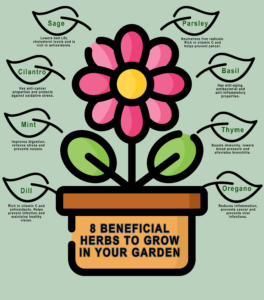
The Seed of an Idea
The concept of food as medicine is not new. Ancient civilizations recognized the inherent medicinal properties in herbs and vegetables. Today, this wisdom is being rediscovered by individuals seeking to enhance their health through natural means. Starting or maintaining a food garden can be a journey into understanding the synergy between nature and wellness.
Groundwork for Growth
Before you put on your gardening gloves, it’s crucial to understand your local climate and soil type. These factors dictate what will flourish in your garden. Herbs, in particular, are forgiving and often thrive with minimal fuss. They are the perfect starting point for both novice and seasoned gardeners. Most herbs require full sun for at least six hours a day, and well-drained soil is a must to prevent root rot.
The Healing Harvest
Imagine stepping into your garden and being greeted by an array of verdant herbs, each with its unique profile of health benefits. Here are eight power-packed herbs that are not only easy to grow but also have remarkable health properties:
| Herb Name | Characteristics | Common Uses |
|---|---|---|
| Sage | Lowers bad LDL cholesterol, rich in antioxidants | Culinary (meats, sauces), medicinal teas, essential oils |
| Parsley | Neutralizes free radicals, rich in vitamin C | Garnishing, flavoring soups and sauces, herbal teas |
| Basil | Anti-aging, antibacterial, anti-inflammatory | Culinary (Italian cuisine, pesto), topical applications for skin, infused oils |
| Thyme | Boosts immunity, lowers blood pressure, alleviates bronchitis | Culinary (seasoning, marinades), medicinal syrups and teas, aromatherapy |
| Mint | Improves digestion, relieves stress, prevents nausea | Culinary (teas, cocktails, desserts), medicinal uses, aromatherapy |
| Oregano | Reduces inflammation, prevents cancer, prevents viral infections | Culinary (Mediterranean cuisine), medicinal teas, essential oils |
| Dill | Rich in vitamin C and antioxidants, helps maintain healthy vision | Culinary (pickling, salads, fish dishes), medicinal uses for digestion |
| Cilantro | Has anti-cancer properties, protects against oxidative stress | Culinary (salsas, curries, garnishes), detoxifying remedies |
Sowing Success
Gardening is not just about planting; it’s also about planning. Companion planting can be a key to success. For instance, basil and tomatoes are not only perfect partners in the kitchen but also in the garden, where basil can help repel harmful insects. Meanwhile, planting chives near roses can prevent black spot and mildew. Diversity in the garden can lead to a healthier ecosystem and, consequently, a more robust harvest.
The Ritual of Routine
Maintaining your green pharmacy requires a routine. Watering, weeding, and harvesting need to become part of your rhythm. Herbs are at their most potent when harvested in the morning after the dew has evaporated but before the sun is at its peak. Regular harvesting also encourages the plants to produce more foliage.
Preserving the Bounty
Your garden’s yield can be preserved in various ways, ensuring you have access to its health benefits year-round. Drying herbs is a simple and effective method to maintain their medicinal properties. Freezing, making tinctures, or infusing oils are other ways to capture the essence of your garden’s bounty.
The Bigger Picture
The beauty of a food garden extends beyond its physical boundaries. It fosters a connection with nature, provides a sense of achievement, and can be a meditative and educational activity for all ages. Moreover, it contributes to sustainability and promotes biodiversity.
Blossoming Wellness
As you tend to your garden, remember that it is not just about the harvest but also about the journey. The patience, care, and attention you give to your plants are often reflected back in the health benefits you reap. Your garden, no matter the size, is a testament to the notion that the simplest changes to our lifestyle can have profound effects on our well-being.
As more people turn to their backyards for health, community, and connection to the earth, the food garden is becoming a canvas for personal and planetary health. So, plant the seeds of wellness today, and watch as your green pharmacy grows into a lush sanctuary of health and harmony.
Please note that while these herbs have been associated with various health benefits, it is important to consult with healthcare professionals before using them for medicinal purposes, especially if you are taking medications or have health concerns.
- The One Skill That Could Save Your Family in a Crisis!
- Turn 1 Week of Harvest Into 6 Months of Food!
- Backyard Chickens: The Secret to Never Buying Eggs Again!
- Save Thousands with This Simple Backyard Water Hack!
- 7 Crops That Practically Grow Themselves (and Feed You Nonstop!)
- This Dirt Trick Could Feed Your Family Forever!
- You Won’t Believe How Much Food Fits in a Tiny Backyard!
- Cultivating Your Greens: A Beginner’s Guide to Starting a Vegetable Garden
- The Green Pharmacy: Cultivating Wellness in Your Backyard

